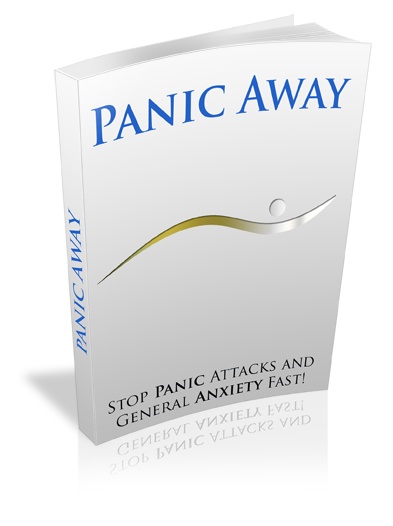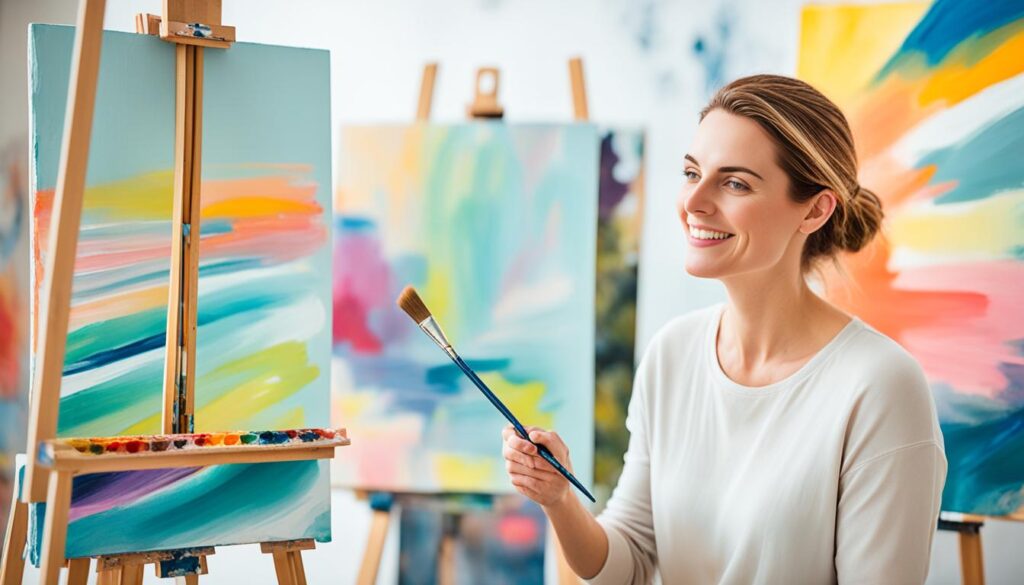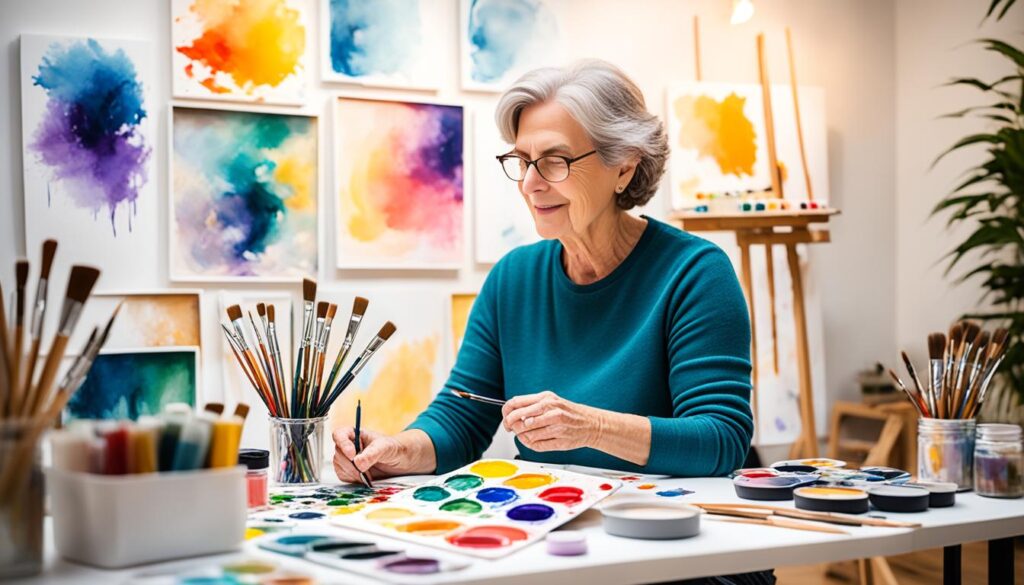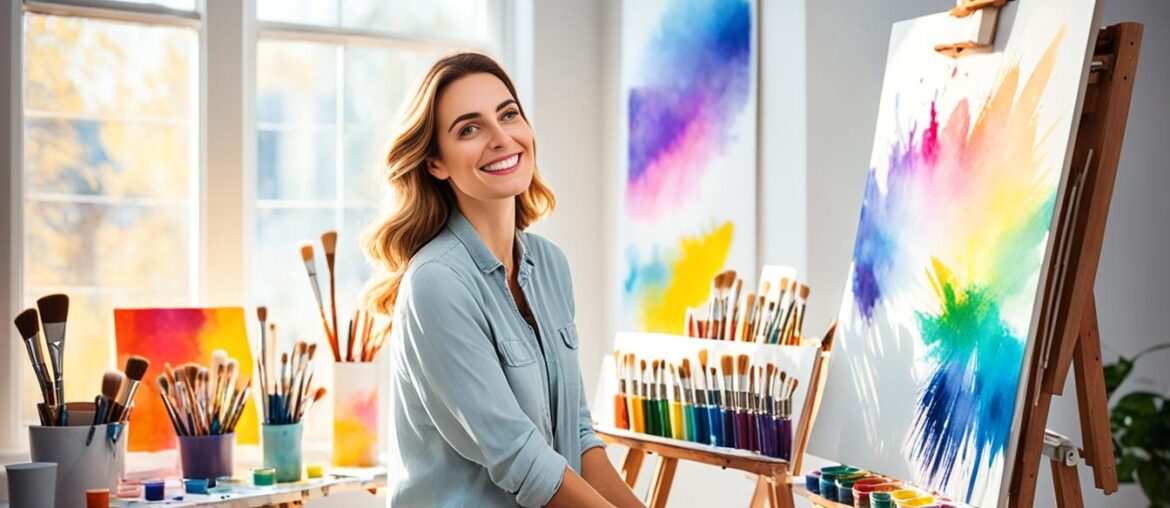Are you tired of feeling overwhelmed by anxiety and stress? Have traditional methods of managing your anxiety fallen short? If so, I can relate.
For years, I struggled with anxiety, searching for a solution that could provide me with some relief. That all changed when I discovered the incredible benefits of therapeutic painting classes.
Our Top Pick For Beating Panic Attacks

Stopping, and preventing, panic attacks is now even easier.
Painting therapy, also known as art therapy, has been a game-changer for my mental health. It has allowed me to find a sense of calm in the midst of chaos and express my emotions in a way that words cannot always capture.
Through these creative workshops for mental health, I have learned to tap into my inner creativity and use it as a powerful tool for anxiety relief. The therapeutic art sessions have provided me with a safe and supportive environment to explore my emotions, improve my coping abilities, and regain a sense of control over my mental well-being.
Join me on this journey of healing and self-discovery as we delve into the world of therapeutic painting classes and uncover the profound impact they can have on anxiety relief.
Key Takeaways:
- Therapeutic painting classes offer a holistic approach to anxiety relief through art therapy.
- These classes create a safe and supportive environment for individuals to explore their emotions.
- Art therapy provides a powerful tool for coping with anxiety and expressing emotions.
- The creative process in painting classes fosters relaxation, self-discovery, and mindfulness.
- Engaging in art therapy can lead to improved mental well-being and a greater sense of control over anxiety.
The Therapeutic Potential of Art Therapy
Art therapy is a versatile form of therapy that allows individuals to delve into their inner thoughts, feelings, and experiences through creative expression. It has a wide range of therapeutic potential and is applicable to individuals of all age groups. Art therapy has been integrated into health promotion efforts and the enhancement of recovery from illnesses.
Art therapy techniques have evolved beyond traditional mental health institutions. They have expanded to various community settings, including schools, shelters, nursing homes, and residential treatment facilities. This widespread adoption showcases the recognition of art therapy's effectiveness in promoting well-being and supporting mental health in diverse populations.
Through art therapy, individuals can engage in a variety of creative expressions to explore their emotions and experiences. Painting and drawing are just two examples of how individuals can express themselves in a therapeutic and meaningful way.
Art therapy is a recognized field that requires certification and training in both art and therapy. Professionals in this field are trained to guide individuals through the creative process, helping them tap into their inner selves and find healing, personal growth, and self-discovery.
Art Therapy for Stress Reduction
In today's fast-paced and demanding world, stress has become a common part of our lives. Fortunately, art therapy offers a powerful way to reduce stress and promote relaxation, creativity, and overall well-being. By engaging in creative activities and expressing oneself through art, individuals can effectively manage intense emotions, foster self-awareness and self-worth, and find solace in the midst of chaos.
Art therapy has been proven to be a valuable tool for stress and anxiety reduction. Through the process of creating art, individuals can enter a state of flow where they become fully absorbed in the present moment. This promotes mindfulness, allowing them to detach from their worries and focus on the act of creation. As a result, stress and anxiety levels decrease, and a sense of calm and tranquility takes their place.
Art therapy also helps individuals tap into their creativity. The act of creating something new and unique stimulates the brain, leading to a sense of accomplishment and satisfaction. This creative expression can be an outlet for emotions that are difficult to put into words, allowing for a deeper level of self-expression and understanding.
“Art has the power to heal and transform, providing a safe space for individuals to explore their thoughts and emotions on a deeper level.” – Art Therapist Emma Smith
Moreover, art therapy has been shown to aid in pain management. The act of creating art can serve as a positive distraction from physical discomfort, providing individuals with a much-needed respite from their pain. It can also help individuals develop coping mechanisms for managing their pain, empowering them to take an active role in their own well-being.
The Benefits of Art Therapy for Stress Reduction:
- Promotes relaxation and mindfulness – Engaging in art therapy allows individuals to focus their minds on the present moment, promoting a sense of tranquility and peace.
- Enhances creativity – The creative process stimulates the brain and encourages individuals to explore new ideas and perspectives.
- Fosters self-expression and self-awareness – Through art, individuals can express their thoughts, emotions, and experiences, leading to a deeper understanding of themselves and their needs.
- Provides a positive outlet for stress and anxiety – Art offers a safe and constructive way to release intense emotions, reducing stress and promoting emotional well-being.
- Aids in pain management – Art can serve as a positive distraction from physical pain and provide individuals with a sense of control over their own healing.
Incorporating art therapy into your life can have a profound impact on your overall well-being. Whether you engage in guided art therapy sessions or simply create art on your own, the act of self-expression and creativity can provide immense relief from stress and help you achieve a greater sense of inner peace.

Art therapy for stress reduction is a powerful and accessible tool that anyone can incorporate into their daily lives. Whether you're painting, drawing, or engaging in other forms of artistic expression, the benefits are undeniable. So, take some time for yourself, indulge in the therapeutic process of creating art, and experience the profound impact it can have on your stress levels and overall well-being.
The Role of Art Therapy in Emotional Healing
Art therapy plays a significant role in emotional healing by fostering self-awareness, promoting emotional processing, and providing an outlet for emotional release. Through the creative process, individuals can explore and express their emotions, helping them gain a deeper understanding of themselves and their experiences.
Art therapy has been particularly beneficial for individuals who have experienced trauma or are struggling with mental health disorders. It allows them to externalize and process their emotions in a safe and supportive environment, leading to healing and personal growth.
https://www.youtube.com/watch?v=yhKL3CuUxNs
Benefits of Art Therapy in Emotional Healing:
- Facilitates self-awareness and self-expression
- Promotes emotional processing and understanding
- Provides a safe and supportive environment for emotional release
- Aids in healing and personal growth
- Offers a non-verbal form of communication for individuals who struggle with verbal expression
Art therapy provides individuals with a creative and therapeutic outlet to explore and process their emotions, allowing for healing and personal growth.” – Art Therapy Association
By delving into the world of art, individuals can tap into their inner emotions, uncovering insights and discovering new ways of understanding and coping with their experiences. The act of creating art can serve as a powerful tool for emotional healing, helping individuals navigate through their challenges and find a sense of peace and balance.
| Art Therapy Techniques | Benefits |
|---|---|
| Painting | Encourages self-expression and emotional release |
| Drawing | Promotes self-awareness and mindfulness |
| Sculpting | Fosters a sense of control and empowerment |
| Collage | Allows for exploration of complex emotions |
| Photography | Captures moments of self-reflection and self-discovery |
The Impact of Art Therapy on Self-Confidence
Art therapy has a profound impact on self-confidence, fostering personal growth and creative expression. Regardless of artistic ability, engaging in art-making allows individuals to build confidence in their creative skills and find pride in their artistic accomplishments. The supportive and non-judgmental environment of art therapy encourages individuals to take risks, explore new ideas, and embrace their unique artistic style. This process of self-expression and self-discovery leads to increased self-esteem and a greater sense of self-worth.
Through art therapy, individuals are provided with a safe space to explore their creativity and push their boundaries. The therapeutic process allows participants to tap into their inner thoughts, emotions, and experiences, enabling them to express themselves authentically. By engaging in the artistic process, individuals have a tangible representation of their inner world, promoting self-reflection, introspection, and personal growth.
The act of creating art in a supportive environment also allows individuals to overcome self-doubt and fear of judgment. Art therapy encourages individuals to embrace their artistic abilities, regardless of societal standards or preconceived notions of “good” art. This acceptance and validation of personal artistic expression boosts self-confidence and self-acceptance, enabling individuals to celebrate their unique creativity.
Art therapy has the power to transform individuals' perception of themselves and their artistic abilities. Through the guidance of trained art therapists, participants in art therapy sessions learn to channel their emotions, thoughts, and experiences into their artwork. As they witness the development of their artistic skills and the progress in their artwork, individuals gain confidence in their abilities and recognize the value of their creative expression.
Achieving Personal Growth Through Art Therapy
Art therapy not only enhances self-confidence and artistic ability but also promotes personal growth. Through the creative process, individuals are empowered to explore their emotions, confront their challenges, and develop coping mechanisms. The art-making experience in art therapy provides a platform for self-discovery, encouraging individuals to delve deeper into their inner thoughts and embark on a journey of personal transformation.
By engaging in art therapy, individuals gain a deeper understanding of themselves and their experiences. They develop a sense of self-empowerment as they navigate the artistic process, making decisions, experimenting with different techniques, and witnessing the growth in their artwork. This journey of self-expression fosters resilience, adaptability, and a heightened sense of self-awareness.
Through art therapy, individuals are also given the opportunity to confront and process their emotions in a safe and supportive environment. The creative process serves as a therapeutic outlet for emotional release, enabling individuals to express and release pent-up feelings. By externalizing their emotions through art, individuals can gain a new perspective on their experiences, allowing for emotional healing and personal growth.
Overall, art therapy has a profound impact on self-confidence, providing individuals with the platform to cultivate their creative expression, enhance their self-esteem, and nurture personal growth. Through the power of art, individuals can embark on a transformative journey of self-discovery, self-acceptance, and self-empowerment.

| Benefits of Art Therapy on Self-Confidence | How Art Therapy Promotes Self-Confidence |
|---|---|
| 1. Enhanced self-esteem | 1. Non-judgmental and supportive environment |
| 2. Increased sense of personal accomplishment | 2. Embracing unique artistic style |
| 3. Boosted creative expression | 3. Overcoming self-doubt and fear of judgment |
| 4. Expanded artistic abilities | 4. Tangible progress and development in artwork |
| 5. Greater self-acceptance | 5. Validation and acceptance of personal artistic expression |
Drawing and Painting as Stress Relief Techniques
Drawing and painting are powerful techniques used in art therapy to alleviate stress and promote relaxation. These creative activities provide individuals with an outlet to express themselves, engage their creativity, and find solace in the present moment.
When we immerse ourselves in drawing and painting exercises, we can temporarily escape the burdens of daily life and focus our attention on the therapeutic process. Whether it's the stroke of a brush or the precise lines of a pencil, the act of creating art allows our minds to quiet down and find a sense of calm.
Studies have shown that drawing and painting have a direct impact on our brain chemistry. Engaging in these activities can increase dopamine levels, a neurotransmitter associated with pleasure and reward. Individuals with anxiety, depression, and excessive stress often have low levels of dopamine, making drawing and painting particularly beneficial for those experiencing mental illnesses.
Furthermore, the creative process involved in drawing and painting stimulates our imagination and taps into our innate creativity. This engagement with our artistic side not only brings feelings of relaxation but also provides an avenue for self-expression and exploration. By allowing ourselves to freely create without judgment, we can uncover hidden emotions, process our thoughts, and gain a deeper understanding of ourselves.
| Benefits of Drawing and Painting as Stress Relief Techniques |
|---|
| 1. Relaxation and mindfulness – Engaging in drawing and painting exercises offers a pathway to relaxation and helps individuals find a sense of mindfulness in the present moment. |
| 2. Increased dopamine levels – These activities can boost dopamine levels, improving mood and providing a natural source of stress relief for individuals with mental illnesses. |
| 3. Creative expression and exploration – Drawing and painting allow for the free expression of emotions, thoughts, and ideas, fostering self-discovery and personal growth. |
| 4. Stress reduction – Engaging in the creative process of drawing and painting supports stress reduction and provides a healthy outlet for emotions and tension. |
By incorporating drawing and painting into our lives as stress relief techniques, we can tap into our creativity, promote relaxation, and find solace in the act of artistic expression. Whether we are experienced artists or complete beginners, the simple act of picking up a brush or pen can have profound effects on our mental well-being.
Art Therapy Exercises for Stress Reduction
Art therapy offers a variety of exercises that can be used for stress reduction. Engaging in these exercises allows individuals to tap into their creativity, express themselves, and find relaxation. Whether it's working with ceramics and clay, sculpting, doodling or scribbling, creating collages, working with fabrics and textiles, using coloring books, keeping art journals, or exploring photography, each exercise provides a unique way to engage in the creative process and find relief from stress.
“Artistic expression is a powerful tool for stress reduction, allowing individuals to find solace and comfort in the creative process.”
Working with ceramics and clay provides a tactile and therapeutic experience, allowing individuals to mold, shape, and create. This exercise encourages mindfulness and delicate design, providing a calming and meditative activity. Sculpting, on the other hand, allows individuals to express themselves in three-dimensional forms, exploring different textures and shapes.

Doodling or scribbling can be a spontaneous and free-flowing exercise that helps individuals release anxiety and tension. It allows for uninhibited self-expression and enables individuals to explore their subconscious thoughts and emotions. Collages offer a creative and visual way to explore personal themes and narratives, combining various images and materials to create a cohesive piece of art.
Working with fabrics and textiles provides a hands-on experience that can be both soothing and meaningful. Whether it's sewing, stitching, or weaving, this exercise allows individuals to engage with different textures while expressing themselves artistically. Coloring books offer a calming activity that promotes focus and relaxation. The repetitive motion of coloring can help individuals enter a meditative state and reduce stress.
Art journals provide a safe space for individuals to express their emotions, thoughts, and experiences through visual and written forms. They offer a therapeutic outlet for self-reflection and self-discovery. Photography, as an art therapy exercise, allows individuals to capture moments, express their unique perspective, and engage with the world around them.
“Engaging in art therapy exercises fosters self-expression, mindfulness, and promotes overall well-being.”
By taking part in these art therapy exercises, individuals can find a sense of calm, reduce stress, and tap into their creativity. Each exercise offers a different approach to self-expression and can provide a therapeutic outlet for emotional release. Art therapy exercises for stress reduction are not only enjoyable but also contribute to overall well-being and personal growth.
The Benefits of Drawing in Art Therapy
Drawing is a versatile and powerful activity in art therapy that offers numerous benefits for individuals seeking stress relief and emotional expression. Through the act of drawing, individuals can engage in mindfulness, connect with their emotions, and promote self-discovery and healing. Let's explore the various benefits that drawing brings to art therapy.
Promotes Mindfulness and Emotional Awareness
When we draw, we are fully present in the moment. The act of putting pen or pencil to paper requires focus and attention to detail, allowing us to enter a state of mindfulness. As we create strokes, lines, and shapes on the paper, we become more aware of our thoughts, emotions, and bodily sensations. Drawing enables us to tune into our inner world, giving us a deeper understanding of ourselves and our experiences.
Calms the Mind and Reduces Stress
Engaging in drawing has a calming effect on the brain. It allows us to shift our focus from external stressors to the creative process at hand. Research has shown that drawing can reduce cortisol levels, the hormone associated with stress, helping individuals experience a sense of relaxation and calmness. Through drawing in art therapy, we can effectively manage stress and find inner peace.
Targets the Amygdala and Supports Emotional Regulation
Coloring, a form of drawing, specifically targets the amygdala, the brain's fear center. When we engage in coloring activities, we activate the amygdala and stimulate neural connections related to emotional regulation. By coloring intricate patterns or focusing on specific hues, we can practice mindfulness and enhance our ability to regulate our emotions. Drawing in art therapy, including coloring, can contribute to emotional well-being and stability.
Expresses Emotions and Facilitates Self-Discovery
Drawing provides a creative outlet for emotional expression and self-discovery. Through the use of lines, shapes, colors, and symbols, we can visually communicate our feelings, thoughts, and experiences. Art therapy allows us to explore our inner world without relying solely on verbal language. Drawing fosters a safe and non-judgmental environment for expressing complex emotions that might be difficult to articulate in words. It opens the door to self-discovery and personal growth.

Enhances Communication and Symbolic Expression
Drawing serves as a potent language of symbols and visual metaphors. Through art therapy, we can communicate and express ourselves in a non-verbal, abstract manner. Drawing allows us to articulate our thoughts and feelings through images, connecting us to our unconscious mind and revealing profound insights. It enables us to express ourselves beyond the limitations of language, fostering communication and understanding with ourselves and others.
The Benefits of Drawing in Art Therapy
| Benefits | Description |
|---|---|
| Promotes Mindfulness and Emotional Awareness | Drawing helps individuals enter a state of mindfulness and connect with their emotions. |
| Calms the Mind and Reduces Stress | Drawing has a calming effect on the brain, reducing stress and promoting relaxation. |
| Targets the Amygdala and Supports Emotional Regulation | Coloring, a form of drawing, stimulates the amygdala and enhances emotional regulation. |
| Expresses Emotions and Facilitates Self-Discovery | Drawing provides a creative outlet for expressing emotions and exploring one's inner self. |
| Enhances Communication and Symbolic Expression | Drawing allows for non-verbal communication and the use of symbols and visual metaphors. |
Through drawing in art therapy, individuals can unlock the transformative power of creativity and use it as a tool for stress relief, emotional expression, and self-discovery. Whether it's through mindful strokes, soothing colors, or symbolic representations, drawing offers a unique avenue for healing, growth, and self-reflection in the therapeutic process.
Conclusion
Therapeutic painting classes offer a transformative experience for individuals seeking anxiety relief through art therapy. These classes provide a holistic approach, combining creative expression and therapeutic techniques to promote overall well-being and support mental health.
Engaging in art therapy exercises, such as drawing and painting, allows individuals to tap into their emotions, process their thoughts, and find relaxation and mindfulness in the present moment. Through the power of art, individuals can experience stress reduction, emotional healing, increased self-confidence, and enhanced creativity.
Whether participating in a structured therapeutic painting class or practicing art therapy individually, the benefits are undeniable. The expressive nature of therapeutic painting allows individuals to explore their inner selves, foster self-awareness, and gain a deeper understanding of their emotions and experiences.
Therapeutic painting classes encompass a safe and supportive environment that encourages self-expression, growth, and personal development. By embracing the healing power of art, individuals can find solace and relief from anxiety, while also nurturing their creativity and enhancing their overall well-being.
FAQ
What are therapeutic painting classes?
Therapeutic painting classes are art classes that incorporate art therapy techniques for anxiety relief and emotional well-being. These classes provide a safe and supportive environment for individuals to explore their emotions and experiences through creative expression.
Who can benefit from therapeutic painting classes?
Therapeutic painting classes are suitable for individuals of all age groups and can be beneficial for anyone seeking stress relief, relaxation, emotional healing, self-confidence, and enhanced creativity. These classes have been proven to be particularly helpful for individuals dealing with anxiety, depression, trauma, chronic pain, or other mental health conditions.
What are the benefits of therapeutic painting classes for anxiety relief?
Therapeutic painting classes offer numerous benefits for anxiety relief, including stress reduction, emotional healing, increased self-confidence, and enhanced creativity. Engaging in art therapy exercises, such as drawing and painting, can help individuals manage intense emotions, foster self-awareness, and promote mindfulness, leading to a sense of calm and overall well-being.
How does art therapy help in stress reduction?
Art therapy promotes relaxation, creativity, and overall well-being, making it an effective method for reducing stress. Engaging in creative activities and expressing oneself through art enables individuals to focus on the present moment, fostering mindfulness and helping to alleviate stress. The process of creating art provides a positive outlet for individuals to cope with stressors in their lives, resulting in decreased stress and anxiety levels.
Can art therapy help with emotional healing?
Yes, art therapy plays a significant role in emotional healing by fostering self-awareness, promoting emotional processing, and providing an outlet for emotional release. Through creative expression, individuals can explore and express their emotions, leading to a deeper understanding of themselves and their experiences. Art therapy has been particularly beneficial for individuals who have experienced trauma or are struggling with mental health disorders.
How does art therapy impact self-confidence?
Engaging in art therapy exercises, regardless of artistic ability, allows individuals to build confidence in their creative skills and find a sense of pride and accomplishment in the art they create. The supportive and non-judgmental environment of art therapy encourages individuals to take risks, explore new ideas, and embrace their unique artistic style. This process of self-expression and self-discovery can lead to increased self-esteem and a greater sense of self-worth.
What are some art therapy exercises for stress reduction?
Art therapy offers a variety of exercises for stress reduction, including ceramics and clay work, sculpting, doodling or scribbling, collages, fabrics, coloring books, textiles, art journals, and photography. Each of these exercises provides a unique way for individuals to engage in the creative process and express themselves, helping them relax, de-stress, and tap into their creativity.
What are the benefits of drawing in art therapy?
Drawing is a widely used activity in art therapy due to its numerous benefits for stress relief. Drawing promotes mindfulness, helps individuals tune into their emotions, thoughts, and body, and has a calming effect on the brain. It can also reduce cortisol levels, which are often elevated in individuals experiencing stress. Coloring, a form of drawing, specifically targets the amygdala, the brain's fear center, and helps individuals practice mindfulness, providing additional stress relief.
How do therapeutic painting classes promote anxiety relief?
Therapeutic painting classes offer a holistic approach to anxiety relief through art therapy. By incorporating creative expression and therapeutic techniques, these classes provide benefits such as stress reduction, emotional healing, increased self-confidence, and enhanced creativity. Engaging in art therapy exercises, such as drawing and painting, allows individuals to tap into their emotions, process their thoughts, and find relaxation and mindfulness in the present moment.



